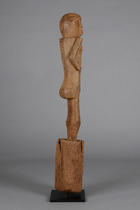Poteau figuratif "ngya", 19e/début 20e siècle · Sud Soudan, Bongo · ID: 3045046
Serge Schoffel, Brussels, Belgium
Description
wood, base
During his lifetime, a Bongo man could gain honor and prestige by successfully hunting large animals such as buffalos, elephants, lions, and leopards, or by achieving victory in combat.
These funerary sculptures would have been added to the sepulture by relatives about a year after an important man’s death, on the occasion of a large feast. The deceased’s life story was told and his exploits are praised by members of his family.
Most Bongo posts were erected in commemoration of imprtant men, but remarkable women were sometimes also accorded this privilege.
These anthropomorphic posts are not intended to be naturalistic representations of the deceased, but they feature personal adornments such as bracelets and scarification patterns that can be seen as clear markers of identity. The central figure representing the honored individual was not the only sculpture adorning the grave site; it was often accompanied by representations of the man’s wife, children, and sometimes even his victims. Completing the installation were abstract posts featuring series of stacked notches, which indicate the number of successful hunts achieved by the deceased.
This ensemble of wooden monuments and the scale of the feast confirm the title and rank attained by the deceased during his lifetime, and ensure that he maintains that place of distinction in the afterlife.
L’objet Poteau figuratif “ngya”, 19e/début 20e siècle numéro d’objet 3045046, a fait partie de l’enchère 90.I Tribal Art ainsi que 90.II Contemporary Native American Art en 17 novembre 2018 pour la dernière fois le Zemanek-Münster Hôtel des ventes et avait le numéro de lot 87.
Vous trouverez ici d’autres objets et des informations utiles sur le thème Art africain.
Publications
Schoffel, S., Baeke, V. et al., "Art en premier", Brussels 2017, p. 118 & 121
AHDRC: 0154003






